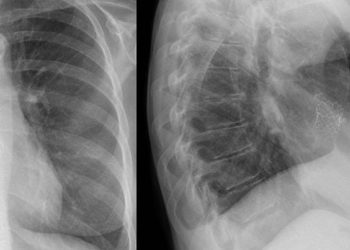Antepartum and intrapartum events both linked to neonatal HIE
Image: PD
1. Increased gestational age was the only antepartum factor independently noted to increase risk of neonatal hypoxic ischemic encephalopathy (HIE).
2. Multiple intrapartum factors were found to be independently related to HIE. These included prolonged rupture of membranes, abnormal cardiotocography, thick meconium, sentinel event, shoulder dystocia, tight nuchal cord, and failed vacuum delivery.
Evidence Rating Level: 3 (Average)
Study Rundown: Neonatal HIE is defined as neurologic symptoms following an acute event resulting in hypoxia-ischemia within 24 hours of birth. HIE diagnosis excludes infants who develop encephalopathy secondary to known infection, trauma, inborn errors of metabolism, and genetic disorders. The specific etiology behind HIE is still unknown, though previous studies have pointed to antepartum events as large contributing factors. This case-control study looked at both antepartum and intrapartum risk factors in infants with HIE confirmed with neuroimaging and compared them to healthy controls. Only one antepartum factor, increased gestational age (GA), was independently associated with HIE; case infants were noted to be more than twice as likely to be born at GA ≥ 41 weeks when compared to control infants. In comparison, multiple intrapartum factors were independently linked to HIE. Though a strong case-control study due to the number of infants studied, this report is limited by the use of case and control groups from different populations. Additionally, placental abnormalities, which have been suggested as one potential HIE etiology, were not included in this study. Further research into the timing and possible causation of both antepartum and intrapartum events leading to HIE is suggested to better elucidate the pathophysiology of this disease process and guide treatment.
Click to read the study published today in Pediatrics
Relevant Reading: Antepartum and Intrapartum Risk Factors for Neonatal Encephalopathy at Term
Study Authors, Dr. Frances M. Cowan, PhD, MRCPCH and Dr. Miriam Martinez-Biarge, MD talk to 2 Minute Medicine: Department of Paediatrics, Imperial College, Hammersmith Hospital, London, United Kingdom
“Our data strongly suggest that the intrapartum period is necessary to the pathway leading to acute neonatal encephalopathy and a pattern of brain injury consistent with acute hypoxic-ischemic damage. In contrast to some earlier studies, our data do not support antepartum factors in isolation as being critical. [This is] perhaps because we excluded infants in whom we could identify a specific infective, metabolic, or other cause for their neurological problems. However, our study does not imply that we understand all the processes leading to neonatal encephalopathy of apparent hypoxic-ischemic origin, or why some infants suffer pre-labor fetal distress and even stillbirth. Much more work is needed on how the fetus withstands the stresses of labor, the pre-labor assessment of fetal well-being, the tailored management of labor, on changes in placental function occurring at this time, and on whether inflammation, thombophilic or genetic status may alter susceptibilities to this condition.”
In-Depth [retrospective case-control study]: This case-control study retrospectively enrolled 405 infants of ≥ 35 weeks gestational age diagnosed with encephalopathy of likely acute hypoxic-ischemic origin as confirmed by neuroimaging. Any cases found to be related to infection, trauma, inborn errors of metabolism, and genetic disorders were excluded. Case infants were compared to 293 healthy and neurologically intact infants. Case infants were enrolled from various areas around London from 1992 – 2007, whereas control infants were recruited from a single hospital in London from 1996-1997. After logistic regression analysis, increased GA (≥ 41 weeks) was the only antepartum event independently linked with HIE with those infants born later having significantly higher odds of developing HIE (OR = 2.4; 95% CI 1.18 -4.9). However, multiple intrapartum risk factors were noted to be independently associated with HIE; these included prolonged rupture of membranes, abnormal cardiotocography, thick meconium, sentinel event, shoulder dystocia, tight nuchal cord, and failed vacuum delivery. Significantly more case infants were delivered via emergency cesarean section when compared to controls (50% vs. 11%, p < 0.001).
By Neha Joshi and Leah H. Carr
More from this author: Adult decision rules poor proxy for diagnosing pediatric PE, Pediatric readmissions likely a poor proxy for hospital quality, Quality improvement methods increase adherence to pediatric UTI guidelines, Inhaled nitric oxide in premature infants shows no benefits, Intrapartum maternal asthma linked to increased disease in children
© 2013 2minutemedicine.com. All rights reserved. No works may be reproduced without expressed written consent from 2minutemedicine.com. Disclaimer: We present factual information directly from peer reviewed medical journals. No post should be construed as medical advice and is not intended as such by the authors, editors, staff or by 2minutemedicine.com. PLEASE SEE A HEALTHCARE PROVIDER IN YOUR AREA IF YOU SEEK MEDICAL ADVICE OF ANY SORT.






![Macitentan better than placebo for preventing progression of pulmonary arterial hypertension [SERAPHIN Trial]](https://www.2minutemedicine.com/wp-content/uploads/2013/08/ca68dc0329bef0b42ccae7b6656a0f_gallery-75x75.jpg)
